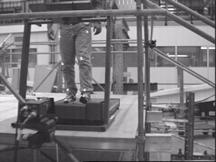
|
|
||||||||

Millennium Bridge
The photos below show how the system works.
 |
 |
The motion of a person walking on the bridge was observed through the motion capture system. The thighs, knees and lower leg were marked with lights so that the three cameras could easily detect these six points. Further lights were attached to the running track, to observe the motion of the bridge in response to the walker's motion. This video shows what was caught by the three cameras.
A model for a pair of legs was developed using geometric algebra, the calibration parameters for the three cameras was derived and an extended Kalman filter was written to track the legs and the motion of the bridge captured by the cameras. The track which resulted from this analysis describes the 3D location of the person's legs and the motion of the bridge at each time frame. It is shown in this video.
For realism, the images obtained were transformed into representations of a humanoid figure walking as shown in this video.
By tracking the movements of a number of people walking 'along' the bridge, and combining these movements with the movement induced in the bridge itself, it should be possible to gain a fundamental understanding of the way motion is induced in this novel type of structure. It may not be of use to the New Millennium Bridge itself, where the problem is likely to be circumvented by the use of damping, but will be invaluable information for bridge designers of the future.